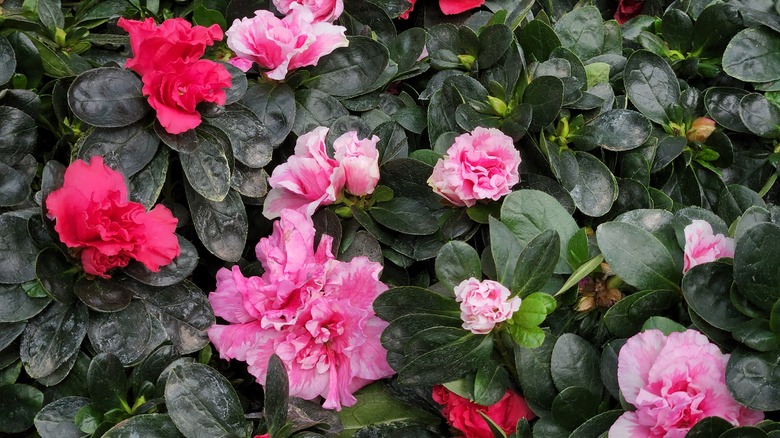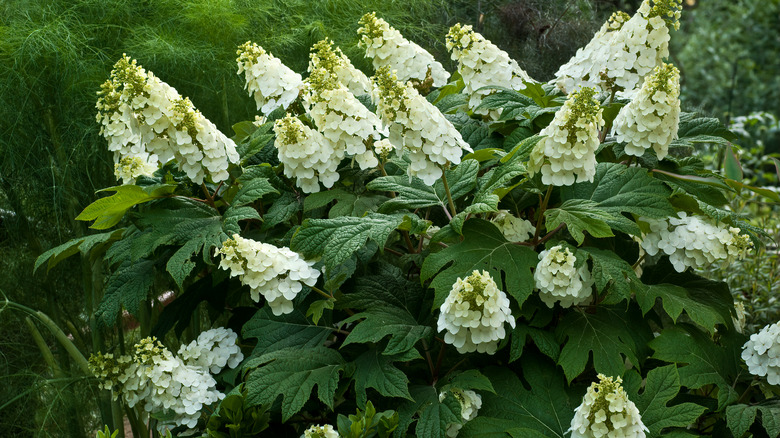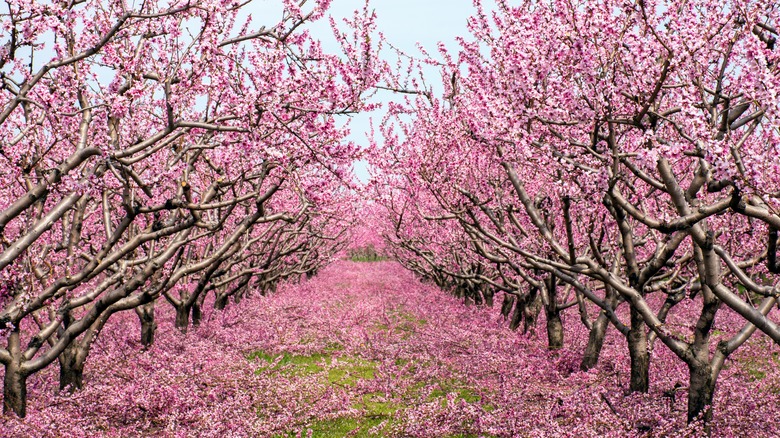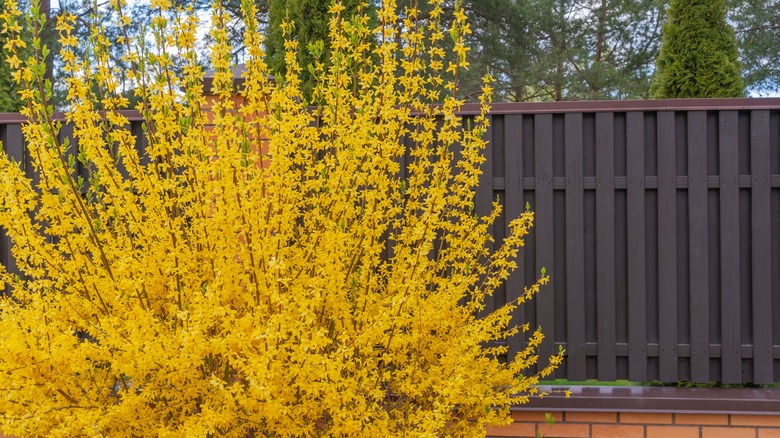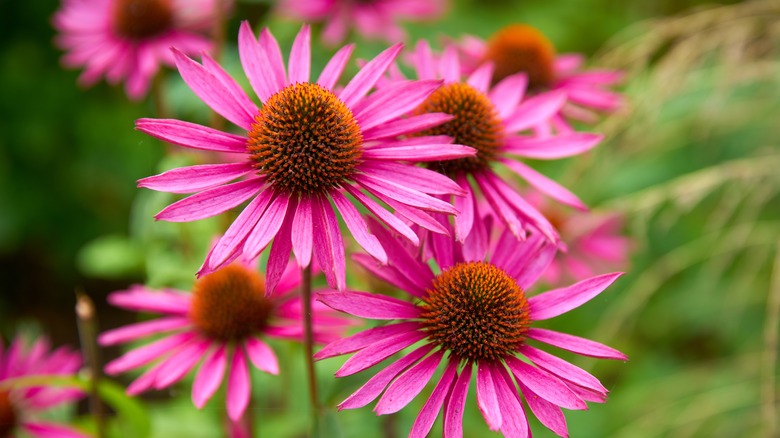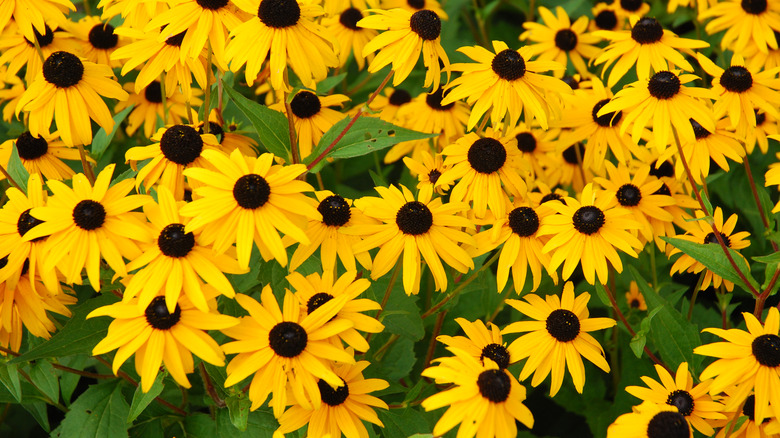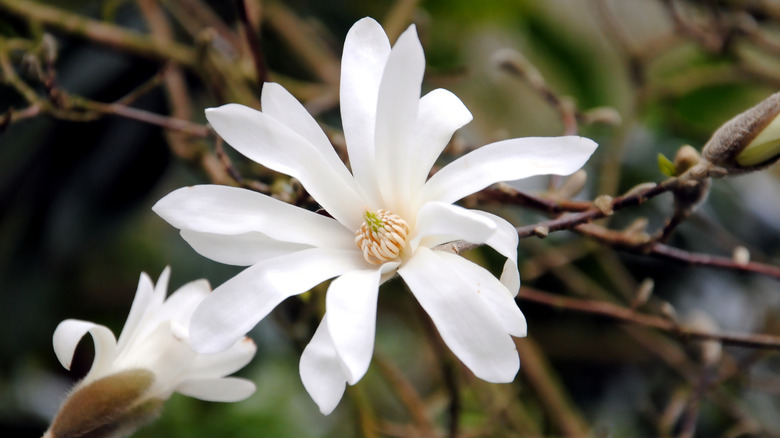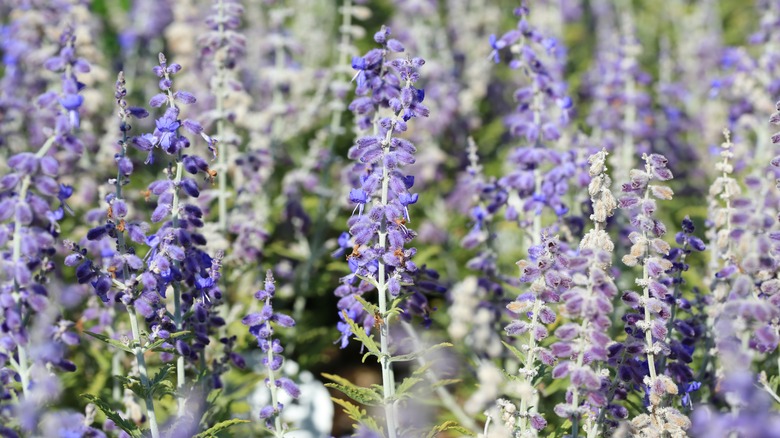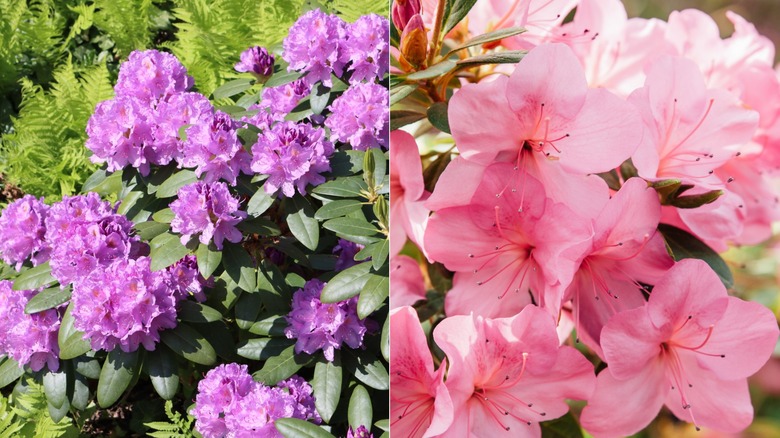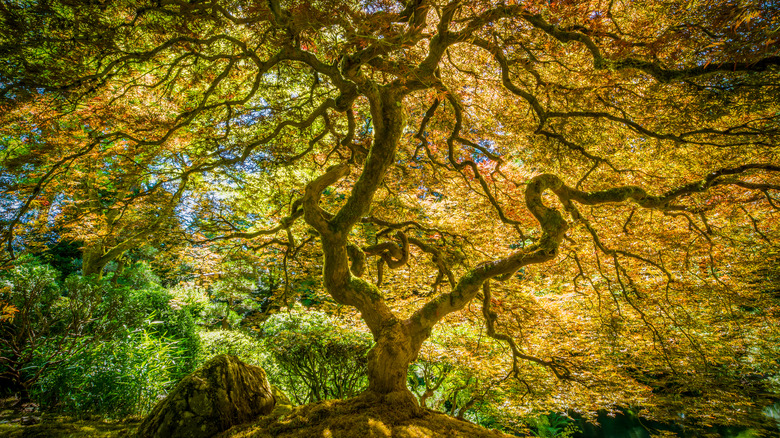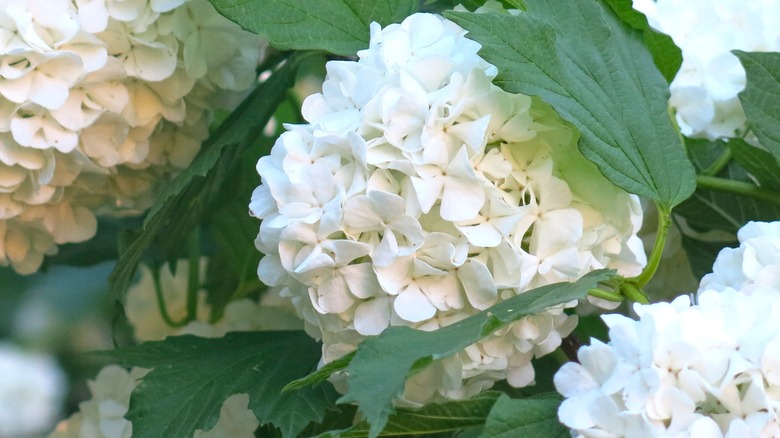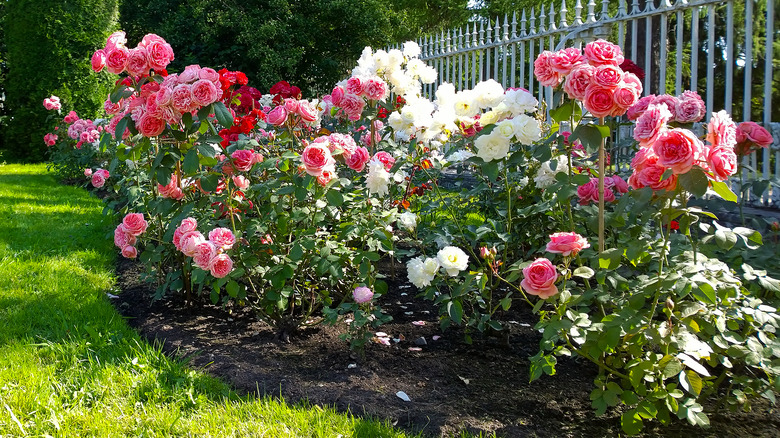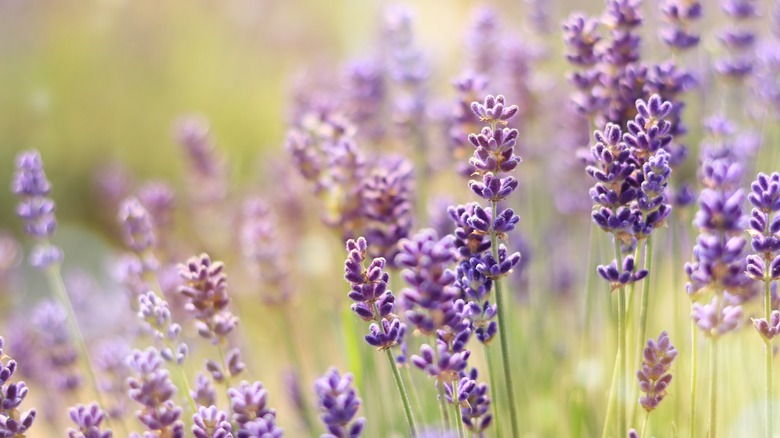Don't Prune Any Of These Plants In The Fall
Anyone who keeps plants knows that there will come a time when things get out of hand. Branches overgrow and become a tangled mess, which can actually cause the plant to become sick and die. A good pruning regimen is required for those hoping to keep their flowers, herbs, trees, and shrubs healthy and alive for a long time to come. However, timing is everything. There are times to prune, and there are times not to prune. All plants have a season. And for the plants on this list, fall is not one of them.
While pruning a plant at the right time will encourage more healthy growth and flowering, pruning one at the wrong time will do the opposite. Premature pruning, or pruning in the wrong season, can cause stunted growth, and even invite disease and pestilence.
Still, with the infinite variety of plants available to consumers, it can be difficult to know which plants shouldn't be pruned in autumn. Thankfully, we're here to help. The following 13 plants should never be pruned in the fall, if you can help it. We'll review their unique characteristics and explain exactly why autumn pruning could spell doom for their livelihood.
Oakleaf hydrangea
The oakleaf hydrangea is unique among hydrangeas in that it is one of the few varieties that is not tolerant of cold weather. A native plant of the southeastern United States, which has an overall warmer climate, oakleaf hydrangea can grow upwards of 8 feet tall if left to its own devices (via North Carolina State University). They have distinctive white, conical blooms, and leaves that look similar in shape to that of an actual oak, hence the name.
The reason this hydrangea cannot be pruned in the autumn is because its flowers bloom from old wood. Any plant that blooms from old wood forms next years' flower buds during the present season. The buds stay dormant over the winter and finally blossom in spring. As the plant takes more energy, the process begins to repeat itself. The best time to prune old wood-blooming plants is right after they have finished flowering in the spring or summer before the new buds have formed.
Because the flower buds are already established in the wood come fall, pruning an oakleaf hydrangea during this time of year will expose the fledgling buds to the elements outside. Without the protection of the bark and sapwood, the buds will die either from exposure or disease. So, if you want the most bloom out of your oakleaf hydrangea, prune within that flowering time window in late spring or early summer.
Flowering fruit trees
Who doesn't love a fruit tree? They are one of nature's most abundant providers. Come spring, the buds on their gnarled branches blossom in beautiful color. Those buds turn to leaves in the summer, providing amazing shade. And during the autumn? They provide an amazing bounty of delicious fruits including apples, peaches, cherries, pears, oranges, apricots, plums, and quince. All of these trees thrive on good pruning, though the proper time to do so might not be when you think.
Fall pruning fruit trees can do some lasting damage. Though you might think it good to give the tree a trim once the fruit falls, you need to be patient and wait a little while for the tree is only just beginning to go dormant. If you prune back in the fall, you are opening the tree up to future vulnerability. Fall pruning can reduce flowering and fruit production while also making the tree vulnerable to diseases and causing a reduction in winter hardiness. And winter hardiness is key to a fruit tree's survival.
The best time to prune fruit trees is during the early spring, when they are completely dormant but there is no worry about frost. This dormancy allows the tree to be pruned back, without putting it at too much risk. Once the tree becomes active again during the spring, it will begin to heal itself and produce new growth, leading to even more flowers and fruit.
Lilacs
Lilacs are beautiful shrubs that can grow up to 30 feet tall and waft tantalizing, yet calming scents throughout your yard (via Michigan State University). A summer blooming plant, lilacs need to be pruned and managed after their full flowering. The window for this is always before the Fourth of July. This pruning regiment will help stimulate more growth, as well as keep the lilac from growing too tall and overtaking everything else that surrounds it.
Since the beauty and fragrance of the lilac are in its flowering blooms, the key to good pruning is to encourage more of that growth and fragrance for the following season. That is why, if you cut your lilacs in the fall, they are not likely to bloom nearly as much as they had the previous season, if at all.
This is because, like the oakleaf hydrangea and several of the other plants on this list, lilacs are an old wood growth plant. If you trim them in the fall, you trim away the dormant buds that have already formed within the plant. With those gone, your lilac bushes won't be nearly as prolific. Plus, the open stems could become host to a whole number of diseases and weather-related hazards.
Forsythia
Despite having the most beautiful yellow blooms, forsythia can grow out of hand very quickly. Like lilacs, forsythia are known to proliferate in an area. If they are not properly maintained, they can often choke out other plants. So, view the following advice from both sides of the landscaping equation. If you love forsythia but are determined to keep it from overtaking your yard, this advice will be beneficial. By the same token, if you are looking for a way to get rid of your forsythia plants, this advice will be beneficial.
Forsythia need to be pruned in the spring after they've already flowered. Like other plants on this list, this well-timed pruning now will encourage further growth, while also keeping the size of the plant in check. Just know that the time window is short. Pruning forsythia in the spring/early summer, before mid-July, will allow them to continue to grow and be vibrant.
As you've likely guessed, fall pruning will do the opposite. Once again, forsythia is a perennial plant that blooms from old wood, meaning that you will be pruning away buds before they have had a chance to bloom, therefore reducing growth. This is helpful if you're looking to drastically cut back your forsythia or get rid of it entirely. Otherwise, wait til spring to prune the branches.
Coneflower
Coneflowers, also known as echinacea, are colorful, long-lasting perennials that don't really need to be pruned at all. They will flower and die back in the same spot year after year. Why are we bothering to put it on this list then? Because it is a plant and, regardless of whether or not it needs to be pruned, someone somewhere is going to want to do so. As such, in order to keep this perennial alive, it is worth knowing that you cannot be prune coneflowers in the fall.
If you want a more maintained look to your garden without self-seeded coneflowers popping up all over the place, you should aim to prune them in the spring after they've flowered. This way, you're removing the large bulbous seed head that makes up the center of the coneflower. This will encourage new growth, but also prevent volunteers from popping up needlessly.
If you prune back the coneflowers in the fall, you are not only effectively killing the plant but also depriving birds of some much-needed winter sustenance. At least when you prune in the spring, more flowers can crop up to replace those cut.
Black-eyed Susan
Black-eyed Susans are among the prettiest perennials available. They will typically re-sow themselves during the fall, as this is the time of year when they begin to wilt with the colder weather. Black-eyed Susans make for interesting plants, because they will actually hold up to pruning in the fall. However, there are some costs to doing so.
Despite being among the most hardy of perennials, pruning a black-eyed Susan in the fall will come with setbacks. First off, you are reducing its ability to self-sow and thereby regain some of its energy during winter dormancy. Also, like the coneflower, you are taking away excellent forage that your local songbird population needs to survive in the winter. Essentially, come spring, you will not have as strong a yield of black-eyed Susans as you would have had you not pruned them in the fall.
Now, this might be a benefit to certain gardeners. If your black-eyed Susan patch is starting to encroach upon other plants, pruning in the fall will help you pair them back. The time at which you prune a black-eyed Susan is a matter of the gardener's preference as to whether or not you want more or less of the flowers. We lean on the "more" side because these perennials just bring so much light and life to a yard.
Star magnolia
Much like with forsythia and lilac, pruning the star magnolia shrub is more of an option. However, this is for a different reason than you might think. Unlike most trees and shrubs, which will heal relatively quickly after they are pruned, star magnolias take a little longer to get over having their limbs lobbed back. This doesn't mean, however, that you shouldn't prune them at all. You just need to be a lot more careful and conscientious about when and how you prune, which is why you should not do so in the fall.
Fall is a time of year when flowering trees and shrubs are just beginning to go dormant. Dormancy allows plants to survive the winter. You want to prune during total dormancy, as the cutting won't present too much damage to the tree. Aim to prune a star magnolia in early spring after the last frost. It will start its healing process quicker once it begins to wake up.
Since the star magnolia is so much slower at healing, if you cut it back in the fall, you risk exposing it to a whole manner of different issues. Disease and pests are primary because the interior of the tree is open due to the cut you've made. Plus, the wound won't have time to close before winter, which means that the tree is now vulnerable to cold and frost, which could all but kill it.
Russian sage
Sometimes mistaken for lavender at a distance, Russian sage is defined by its long stems of purple, fuzzy flowers and make a great addition to any perennial beds you might have. It grows in a small shrub, and takes a little time to establish itself before yielding truly excellent blooms. You generally want to wait until the spring to prune Russian sage, because that's the best time to see where the plant is flowering and what, if any, wood has died over the winter.
If you cut back Russian sage in the fall, you will either bring it back to its original state of infancy, or kill it entirely. Now, it could be that your Russian sage has some issues. The shape could be all wrong, or the health of the plant could be affected. Despite being a relatively hardy shrub, Russian sage can be finicky when it comes to disease. In these instances, fall pruning is totally appropriate.
Cut the sage back to about 6 inches in overall height. This will remove the dead wood, and any disease. You will have a smaller growth in the spring as a result, but hopefully you will have given the Russian sage another lease on life. Just remember that fall pruning is only recommended for diseased plants. If your plant is healthy and happy, wait until spring.
Rhododendron and azalea
Rhododendron and azalea bushes can be lumped into one category because they are brotherly plants. They both have the ability to grow to absolutely insane sizes and have similar-looking blooms when midsummer rolls around. Another reason they are often lumped into the same category is because they both grow in exactly the same way.
We've talked a lot about plants that blossom from old wood in this article, but it is worth multiple mentions because of the fact that the time of year in which you prune them is so vital. Refresher: old wood growth has buds for the next season already grown within the wood by the time fall rolls around. When you cut back a rhododendron or an azalea bush in the fall, you are all but destroying their chances of blooming in the summer. Sure, there will likely be some new growth occurring, as it is nearly impossible to get these plants not to grow. But while the leaves come out of new growth, the blossoms do not. They come out of old growth, which can take a decent time to establish itself.
Trim rhododendrons and azaleas within a three-week window of their blooming. This allows them plenty of time to re-establish themselves and provide new growth for the following year.
Japanese maple
Japanese maples are among the most striking of all deciduous trees. They bloom in beautiful red or golden leaves that come popping out in the spring, and never lose their color during their entire season. Like with all other trees, however, you need to be doing your heavy pruning in the late winter or early spring while the tree is dormant. You can do finer pruning in the summer after the leaves have grown out, but after that is when you should really stop.
As with the flowering fruit trees and other shrubs, to prune a Japanese maple in the fall opens it up, literally, to a whole host of different issues. Even if the wood is diseased or dead on the Japanese maple, you need to wait until the spring to trim them away. Not only will this allow the tree to heal in good time, but provide it with the strength it needs to take on another winter of dormancy.
A fall pruning is not going to kill a Japanese maple as it will for some other plants. However, the chances of it being exposed to frost or disease before it has an opportunity to reach its full dormancy are very high.
Viburnum
Similar to several varieties of hydrangea in their bloom and overall shape, viburnum is an absolutely beautiful addition to any yard or garden. The similarities between the two plant varieties continue because, like the oakleaf hydrangea, viburnum plants are very sensitive to fall pruning. If you take your hedge trimmers to viburnum in the fall, they are very likely to reduce their flowering output in the spring. Viburnum is another one of our plant friends that grows out of old wood. As such, any fall pruning will destroy the dormant buds awaiting bloom in spring.
Rather than pruning in the fall, simply provide your viburnum with a good layer of fresh mulch for the winter. When it does come time to prune, spring will be your best option in order to get it into the shape that you want while also keeping it healthy. This way, the plant can still flower, and you're able to create more necessary airflow between the branches.
The only time it is appropriate to trim viburnum in the fall is when you are removing dead or diseased wood. Much like with Russian sage, the trimming down will allow the diseased section of the plant to restart and get a new lease on life.
Roses
Roses are among the most popular flowers all over the world. People just love to grow them. However, there are specific times in which they need to be pruned in order to produce more and more flowers. It doesn't matter what variety of rose you are growing, the pruning rules remain the same. You need to do your pruning work during the spring and summer in order to foster more growth but also keep the bushes from growing out of hand. One rose pruning process is called deadheading, which removes full blooms and, as a result, encourages more flowers to come up during the season.
Since roses prefer the warmer weather for pruning, they like to be left alone during the fall and winter. Like other types of flowers, extensive pruning in the fall or winter can expose roses to frost damage and disease and prevent them from properly flowering in the spring and summer.
Instead, you can do any real structural work to your rose bushes in early spring. This way, the bush is trimmed back before it becomes too overgrown, and the flowers are encouraged to begin growing.
Lavender
Of all the plants we have listed, lavender really needs to wait until spring for pruning. It loses its flowers over the winter, and, as a result, it can be difficult to spot any dead wood on the plant. Once the lavender starts to bud again in the spring, you will be able to see which ones are blooming and which are not. That is when you trim them, because the less energy the plant is expending on the deadwood, the more can go towards blooming.
If you trim back lavender in the fall, you won't be able to tell which wood is dead, and you will also prevent proper blooming in the summer. Again, this is because lavender grows out of old wood, so its buds are sitting in the plant, waiting to emerge in the spring.
Now, a fall pruning on any of the plants we've listed could have one or many of the effects we've gone over. More often than not, the damage is nothing that cannot be remedied with time, care, and proper pruning. Knowing and understanding the effects of ill-timed pruning beforehand is only going to help you keep your plants good and healthy going into the future.
